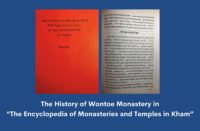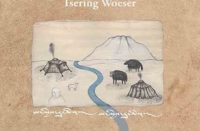
High Peaks Pure Earth presents a translation of “Japanese People and Japanese Literature”, a short article from October 2013 by Tibetan writer and poet Kyabchen Dedrol discussing Japanese literature.
The piece was first posted on his blog on the online literary journal he co-founded “Butter Lamp”. The website is now defunct but the original link used to be: http://www.tibetcm.com/html/degrol/201401125901.html
In this article, Kyabchen Dedrol draws on his own personal experience in Japan and advises Tibetan writers to be more open minded in their literary digest. You can read more from Kyabchen Dedrol in English translation over on Words Without Borders.
“Japanese People and Japanese Literature”
By Kyabchen Dedrol
1
Due to my upbringing I have heard three distinct ways of referring to Japan. Ri bin (རི་པིན་) from the Chinese ‘Rìběn’ (日本), Jar pan (འཇར་པན་) from the English ‘Japan’ and Nyi hong (ཉི་ཧོང་) from the Japanese ‘Nihon’ (日本). At this time, Nyi hong seems most suitable.
In November 2009 I went to Japan on holiday. I was so impressed by both the peaceful and gentle behaviour of the people and the extent of material wealth in the city.
On the plane from Beijing to Tokyo, the train from Kyoto to Osaka and the flight from Osaka to Korea, I read Yukio Mishima’s novel ‘The Temple of the Golden Pavilion’. At times I drank my Asahi beer and pondered off into nothingness. In reality and fantasy, the people and the places of this Eastern country have produced a history, religion and culture, realising good fortune a clear path.
I have forgotten most of the plot of ‘The Temple of the Golden Pavilion’ but I will never forget my special trip. Especially in Tokyo when I saw some young women in traditional Japanese dress strolling leisurely in the shade of the storied houses. And in Kyoto some beautiful women dressed in multi-coloured kimonos of red, green, blue and yellow, were performing in an exhibition of traditional clothing. What a thing good quality clothes and fabric are! How skilled they were at applying just the right amount of rouge to their faces! And with this I thought of these unfading ancient traditions and how they will forever captivate the minds of all people.
2
I prefer to discuss writers with an emphasis on the individual rather than focusing on the national, grouping together a number of writers because of where they are from. If we think of our own Tibetan literature, Shangshung Choewang Drakpa’s poetry were lustrous in style and very exaggerative, and Gendun Chonphel were easy to read and understand. What do they have in common? The only thing they have in common is that they were written in Tibetan.
As a writer and a reader, when I think of Japanese literature, I think of Yasunari Kawabata’s ‘Snow Country’. As the train speeds through the snow covered land, a number of images of flash across the train’s windows. In Ryunosuke Akutagawa’s ‘In a Grove’ all the witnesses, when questioned by the judge, produce a different account of what happened. Senji Kuroi’s short stories have wondrous plots yet are simple and easy to read. When I think of how both Yukio Mishima and Yasunari Kawabata committed suicide, I am unable to think like a literary critic. How many great writers there are. What made the writer special? What kind of style did they employ?
From the pens of Kawabata and these others flow the themes of meeting and parting, birth and death, love, character, isolation, and so on. From this I can see the beauty of Asian literature with steady roots of religion and culture. Our own Tibetan writers have to expand their scope when it comes to the meaning and the composition of their works. If we Tibetans can write like these Japanese writers then it’s possible we can produce a writer like Kawabata. In this world the sight of the stars above moves a person’s heart, they will find that the stars have the potential to free all of our lonely minds.
3
Some people have told me that after the Second World War, the Japanese people began to study western culture intensely and doing so managed to become a powerful and developed nation very quickly. They added that before the war, the Japanese concentrated only on their own culture, closing off their doors. Lately I read a Tibetan translation of Tetsuko’s Kuroyanagi ‘Totto Chan : The Little Girl at the Window’ and learnt that Western literature, music, cinema, dance, education theory and psychology had caught on even before the Second World War. Not only this but I found out the war had actually interrupted the spread of foreign culture in Japan.
After reading Haruki Murakami’s ‘Norwegian Wood’ I found out Western arts became an important part of the lives of university students in post-war Japan. Murakami and other Japanese writers have adopted many motifs and images from Western culture in their own works. Western readers have enjoyed their works. This has helped Murakami become the third Japanese recipient of the Nobel Prize for Literature. A writer’s composition is a product of how far reaching their mind is. I think that like Murakami, we other Asian writers must think outside the confines of an individual culture in our writing.





Follow Us!